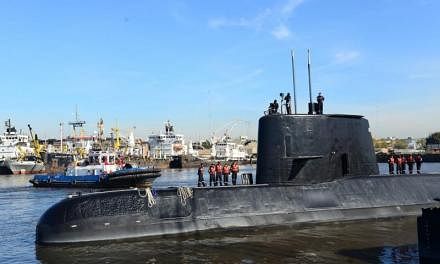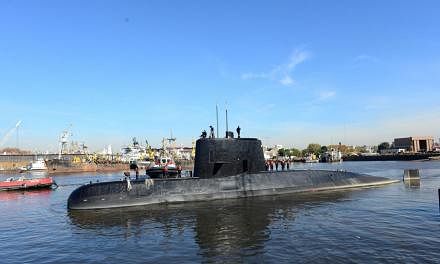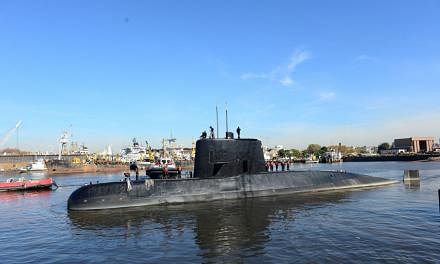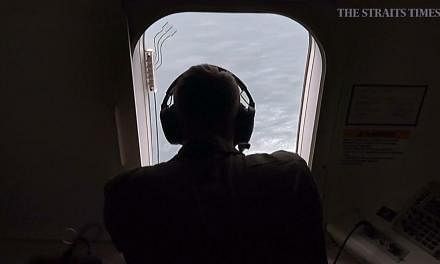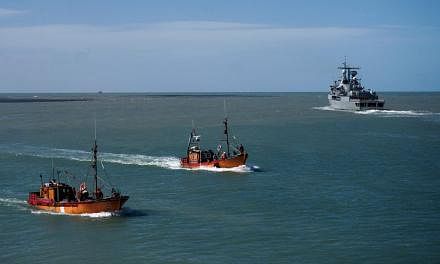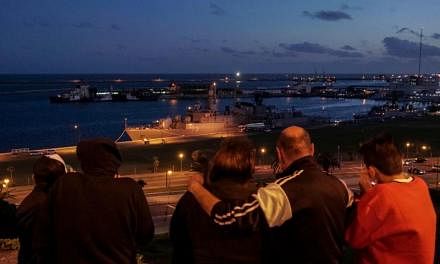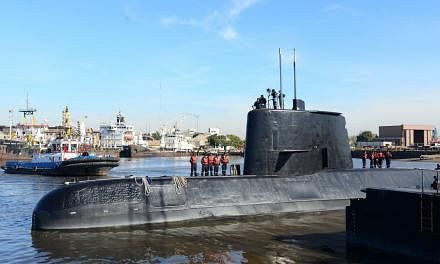WASHINGTON (WASHINGTON POST) - The United States is wrapping up the mission to recover the ARA San Juan, an Argentine submarine that disappeared on Nov 17 and triggered an international effort in a so far futile search to find the ship and its 44 sailors, presumed dead for weeks.
The San Juan departed a base in the southern city of Ushuaia and was scheduled to arrive in late November at the Mar del Plata naval base, about 400km south-east of Buenos Aires.
The Argentine Navy launched a frantic search for the vessel, only able to sustain about a week's worth of oxygen if it could not resurface.
Captain Enrique Balbi, an Argentine Navy spokesman, later said the San Juan was ordered to Mara del Plata after it reported seawater had damaged batteries used for underwater power.
More than 200 US personnel, three aircraft and a Navy research ship participated in rescue and recovery operations east of Patagonia, with a search area of more than 655 square nautical miles, according to a statement from US Southern Command.
The total search area was about 776,996sq km divided among more than a dozen countries, according to a graphic from the Argentine Navy.
Capt Balbi likened the scope of the mission to searching for a cigarette on a soccer field.
The US Navy deployed a P-8 Poseidon reconnaissance aircraft within a day of the incident, said Cmdr Erik Reynolds, a Navy spokesman.
It was later joined by another P-8, a Nasa P-3 Orion research aircraft stocked with powerful scientific instruments and multiple unmanned underwater mapping and salvage vehicles.
A small team will remain in Argentina until Jan 2, and after that, technical assistance will be provided by experts back in the US, Cmdr Reynolds said.
The hopes of family members and rescuers were repeatedly dashed after what seemed to be promising signs of life turned out to be mistakes or false assumptions.
Sonar pings picked up early in the mission were believed to be metallic, but Argentine officials later said they were biological in nature.
In another instance, a life raft and white signal flares were seen in the ocean. They were both found to be unconnected to the San Juan, which had green and red flares, officials said.
A network of oceanographic scientists recorded a "hydro acoustic anomaly" three hours after the last communication with the San Juan, near its last known position, Cmdr Reynolds said.
The Comprehensive Nuclear Test Ban Treaty Organisation, a group that tracks underwater seismic events to determine if they are related to nuclear testing, raised the possibility the event could have been an explosion.
Defence Minister Oscar Aguad sacked Admiral Marcelo Srur, the head of the Argentina Navy, following an investigation of the incident, the Associated Press reported.
Submarine recovery missions are rare. The last time US resources were dispatched was in August 2005, when the Russian mini-sub Priz AS-28 was entangled in nets and cables during a training mission across the Bering Sea.
Though US assets were deployed, the UK's Royal Navy Submarine Rescue Service arrived first, Cmdr Reynolds said, and rescued all seven of the crew.
Every US military operation ends with an after-action review to determine what went right and wrong. That process still has not occurred for the San Juan recovery mission, Cmdr Reynolds said, although lessons will likely revolve around search techniques, equipment deployment and ways to improve coordination with foreign militaries.
"It's easy to give your hopes up from a false lead," Cmdr Reynolds said, speaking for himself as a spokesman. "You have to be cautious; don't get too excited over something that turns out to be a ghost."

